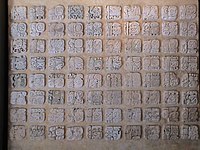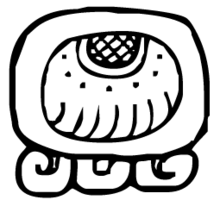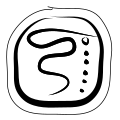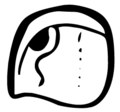Mayan script

The Maya script is the only known fully developed script of pre-Columbian America.
The Maya characters can be found mainly on old buildings and monuments ( e.g. in Tikal ), in the form of wall paintings (e.g. in Bonampak ) or epigraphs , but also on ceramics (e.g. that of the Codex style ) . Only four manuscripts that are definitely authentic, so-called codices , survived the destruction of almost all combustible writers ( Huun ) by Diego de Landa , the Catholic bishop of Yucatán , during the Conquista in the 16th century.
Knowledge of the Maya script had been forgotten since the Spanish conquest. It was almost completely deciphered in the second half of the 20th century. It is now considered legible or interpretable.
overview
The Maya script is a so-called logosyllabic script , which means that the characters can be composed of logograms and syllables . However, the characters can also be separated from each other. In total, half of the approximately 700 characters are logograms or syllables. Most of the time the logograms correspond to actually existing objects or living beings. For some, however, it is no longer possible to recognize the real meaning. In contrast, the syllabograms have a different meaning, namely that of the syllable representation. Most syllabograms are in the consonant - vowel pattern (for example "BA"). Few of them only represent vowels. There were several variants of all logograms and syllabograms, so that the writer could choose the one that best suited his aesthetic understanding. In some cases this was even done through large wall paintings that were supposed to represent only a symbol.
history
Until the end of the 20th century, Mayan script was thought to be derived from the Olmec or isthmus script , but recent discoveries have put the date of the Mayan script back several centuries. Since 2006 at the latest, it is archaeologically probable that the Maya were the inventors of writing in Mesoamerica .
The earliest vertically arranged script glyphs, which are still assigned to the pre-classical period of the Maya, date from the 3rd century BC. From the Mayan archaeological site of San Bartolo (Peten) in Guatemala .
numbers

Decipherment
Basics
In the 16th century, Diego de Landa , Bishop of Yucatan , studied the Mayan characters. He had a noble Maya, presumably Gaspar Antonio Chi , write down the Spanish alphabet in Maya script. Despite misinterpretations, this so-called Landa alphabet served as the basis for later research. Diego de Landa and his collaborators pursued the goal of a consistent implementation of the Christian faith. For example, on July 12, 1562, in a religious zeal, de Landa had everything written in Maya as well as the religious figures and symbols of the Mayas burned in front of the Franciscan monastery of San Miguel Arcángel in Maní , which he justified with the writing Relación de las cosas de Yucatán , so today only parts of four Maya codices have survived. The knowledge of the Maya script was lost as a result of the Christian Conquista, although the language lives on to this day.
There was no research into Maya writing until the 19th century. The complexity of the font, but also errors when copying the glyphs, made a scientific examination difficult.
Deciphering the numbers
Around 1830 Constantine S. Rafinesque-Schmaltz succeeded in understanding the number system of the Maya script. He showed that it is based on dots and dashes (a dot represents a one, a dash represents a five); He also interpreted some signs for different gods, animals and plants.
In 1881 Alfred Maudslay made extensive prints and photographs of the glyphs for the British Museum and was thus able to make copies available to European researchers for the first time.
The ethnologist Cyrus Thomas suspected consonant vowel sequences (e.g. “cu” or “ti”) in the Maya script and made comparisons with the Maya languages still spoken today .
Deciphering the calendar
The basis for deciphering the Maya script was then laid in 1880 by the German linguist Ernst Förstemann (1822–1906), who analyzed the Dresden Maya Code and was able to explain the Maya calendar system and its annual cycles. He showed that the Maya also knew zero and could express very large numbers on the basis of a 20 system . They use these to create extremely precise tables with solar eclipses and Venus phases , from which favorable and unfavorable times for hunting, sowing or warfare emerged.
Förstemann recognized the Maya time system with the so-called calendar round, which consists of three interlocking circles (365 "sunny days" on the outside, 20 names in the middle and 13 numbers in the inner circle) and repeats itself in its constellation after 52 years. He noticed that a certain date that dated into the past kept coming up and interpreted it as the beginning of the Mayan era.
In 1905 the American publisher Joseph Goodman compared the Mayan calendar system with today's calendar and dated the beginning of the Mayan era on February 21, 739 BC. This brought about a breakthrough in the dating of innumerable steles.
Decipherment of syllables and symbols
The Soviet scientist Yuri W. Knorosow took a decisive step in 1952 with the inclusion of the previously misunderstood information in the so-called Landa alphabet , which he correctly interpreted as the syllable characters for the Spanish letter names. He was the first to recognize the mixture of syllables and symbols in the Maya script, which he was able to prove with the word "chi-k'in" (west). Here he was also able to show that a term, here the syllable “chi”, could be represented by different characters.
His hypotheses , which were also shared by the Canadian David H. Kelley (1924-2011), and his initial deciphering of Mayan texts were dismissed as communist propaganda by the leading Mayan researcher in the West at the time, the British JES Thompson , and found up to on Thompson's death (1975) hardly any attention in the West.
Independently of this, Heinrich Berlin and Tatiana Proskouriakoff had proven in 1962 that the monumental stone inscriptions were based on historical and dynastic- genealogical details. It showed the birth, enthronement and marriage of entire dynasties.
From around 1980, the deciphering of the Maya script made rapid and completely unexpected progress, which took place in an international cooperation of a small group of specialists based on rapid communication. An important source of inspiration was the American linguist Floyd Glenn Lounsbury , who stimulated a generation of young researchers, including Linda Schele and David Stuart , who was the youngest recipient of the MacArthur Fellowship's genius grant in 1983 at the age of 18 . They achieved their breakthrough with the deciphering of many previously unknown syllables. A key finding was that many different characters could stand for one syllable.
Over 90% of the Maya writing known today is considered to be legible.
- Variants of a symbol using the example of Caban (day: 17, cardinal point: east, color: red, meaning: movement, earth)
Preserved Mayan Books

Today only four authentic Mayan manuscripts exist :
- The Paris Codex (22 pages) is in the National Library in Paris .
- The Dresden Codex (also Codex Dresdensis, 74 pages) can be viewed in the Saxon State Library in Dresden .
- The Madrid Codex (112 pages) is in the Museo de América in Madrid .
- The Mexico Maya Codex (11 pages); its inscription was initially classified as a forgery, but recent research confirms its authenticity.
Others
Unicode
The Maya script (Maya hieroglyphs) is not yet encoded in Unicode .
Documentary film
David Lebrun made a documentary about the Maya code in 2008, which is based on the book Breaking the Maya Code by Michael D. Coe and describes the individual phases of the decryption in detail. In addition, the methods used are clearly outlined.
See also
literature
- Nikolai Grube : Maya. God kings in the rainforest. Könemann-Verlag, Cologne 2000, ISBN 3-8290-1564-X .
- Maria Longhena: Talking Stones. 200 Mayan characters - the deciphering of their secrets. Fourier, Wiesbaden 2003, ISBN 3-932412-55-9 .
- Michael D. Coe : The Secret of Maya Script. A code is decrypted. Rowohlt, Reinbek near Hamburg 1995, ISBN 3-498-00898-6 .
- Michael D. Coe, Mark van Stone: Reading the Maya Glyphs. Thames & Hudson, London 2005 (2nd edition), ISBN 978-0-500-28553-4 .
- John Montgomery: How to Read Maya Hieroglyphs. Hippocrene Books, New York 2002, ISBN 0-7818-0861-8 .
- Günter Zimmermann: The hieroglyphs of the Maya manuscripts. Walter de Gruyter, Berlin 1956 ( google books book preview).
- Ernst Förstemann : (1902) A historical Mayan inscription. In: Globus, Volume 81, No. 10, pp. 150-153, ISSN 0935-0535 .
Movies
- Breaking the Maya Code. USA 2008 (German: Der Maya-Code. 2008).
- Deciphering the Maya Script: What We Know and What We Don't Know . Presentation by Michael D. Coe at the University of California, Berkeley, October 10, 2000.
Web links
- Detailed description of the Maya script by Sven Gronemeyer
- Early Maya characters (Telepolis)
- Maya writing - Foundation for the Advancement of Mesoamerican Studies, Inc. (FAMSI)
- Mayan glyphs after Wm. E. Gates and Sir JES Thompson
- Mesoweb - site about Mesoamerican cultures with an accent on the Maya and their written language; older articles can be downloaded as PDF. English and Spanish.
- Codex Dresdensis as PDF
- Wolfgang Gockel Heritage
- Illustrated English documentation from the production company for the film by Lebrun
Individual evidence
- ^ William A. Saturno, David Stuart, Boris Beltrán: Early Maya Writing at San Bartolo, Guatemala . In: Science . tape 311 , no. 5765 , 2006, ISSN 0036-8075 , p. 1281-1283 , doi : 10.1126 / science.1121745 , PMID 16400112 .
- ↑ K. Kris Hirst: Maya Writing Got Early Start . In: Science . January 6, 2006. Retrieved September 30, 2013.
- ^ Symbols on the Wall Push Maya Writing Back by Years . In: The New York Times , January 10, 2006. Retrieved May 12, 2010.
- ^ The Dresden Codex . 1200-1250. Retrieved August 21, 2013.
- ↑ Nikolai Grube: The Dresden Maya Calendar: The Complete Codex. Herder Verlag, Freiburg, 2012, ISBN 978-3-451-33332-3 , pp. 21-22.
- ↑ Milbrath, Susan: New Questions Concerning the Authenticity of the Grolier Codex. In: Latin American Indian Literatures Journal. Volume 18, No. 1, 2002, pp. 50-83.
- ^ Doug Criss: This Maya document, long considered a fake, is Americas' oldest manuscript. CNN, September 8, 2016.
- ↑ As Yet Unsupported Scripts (German: Fonts not yet supported). Archaic and Obsolete Scripts (German: Archaic and obsolete scripts). Unicode, Inc., February 24, 2012, accessed February 24, 2012 .
- ↑ The Maya Code (OT: Breaking the Maya Code): The secret of the Maya writing. A code is decrypted. Documentary, USA 2008, written and directed by David Lebrun.









